
What Is a Polyp? Nasal, Colon, and Other Polyps
Polyps Defined
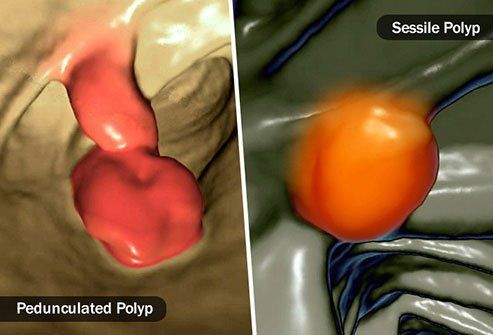
A polyp is a small cell clump that grows within your body. When doctors talk about polyps, they refer to two groups distinguished by their growth pattern. Pedunculated polyps hang from a short stalk. Sessile polyps are flat and they grow directly out of the surrounding tissue.
There are some polyps that can turn into cancer. Others can't. The difference is where they are located, what size they are, and what tissue they are made of. Polyps can appear in various places, from your ears and nose down to your stomach and colon. Read on for details about each polyp type, whether they are prone to becoming cancerous, and how they are medically treated.
What Are Colon Polyps?
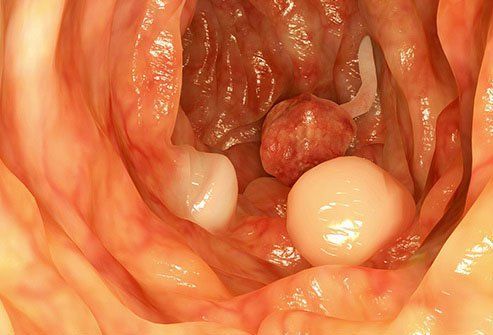
When polyps develop on your colon, they could spell trouble. Colon cancer and rectal cancer usually start out as polyps. That's a frightening fact, as colorectal cancer is the second-leading cause of cancer deaths in the United States. But keep this in mind, too: colon polyps are usually not cancerous.
Colon polyps are quite common. Some estimate that as many as half of adults have them. You're more likely to acquire them if you are male or over age 50. Obesity and cigarette smoking make them more likely, too. Because polyps become more common with age, doctors recommend screening for them starting at age 50. African Americans are at a higher risk of developing colon polyps, and are recommended to begin colonoscopy screenings at age 45.
When they are found in the colon, polyps come in two main types. Hyperplastic polyps are smaller, and they are found close to the end of the colon. They do not cause cancer. Adenomatous polyps can be cancerous, though, particularly if they are large. This takes years, however, and usually they remain noncancerous.
How Are Colon Polyps Diagnosed and Treated?
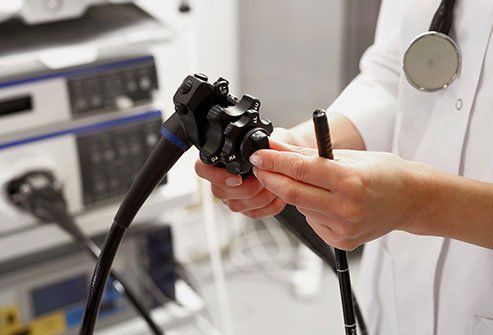
Colon polyps are typically found through colonoscopy. This means a doctor will use a small camera inserted into your anus to examine your colon and rectum. This procedure is recommended every 10 years for adults over age 50, or over age 45 for African Americans.
Colonoscopy Prep
Preparing for a colonoscopy begins two weeks before the procedure. Having an empty bowel is crucial for a colonoscopy. If you don't have an empty colon, the procedure may have to be attempted again at another time. Some patients may experience nausea or vomiting during the preparation period. Soda crackers and starting with small sips of bowel preparation medicine can help. Others may find the skin around their anus irritated from the passage of liquid stools. This can be eased by applying Vaseline around the irritated skin, and by sitting in a warm bath for about 10 minutes after passing stool.
Undergoing Colonoscopy
Your doctor can not only look at the lining of your colon, but also remove polyps for later analysis. You will be placed in a hospital gown and given an IV. You will be sedated and begin to feel drowsy. To perform the colonoscopy, your doctor will instruct you to lie on your side with your knees bent toward your chest. The procedure can cause cramping, which can be relieved by breathing slowly and deeply. The entire procedure takes about half an hour to an hour.
Polyps in the Ears (Aural Polyps)
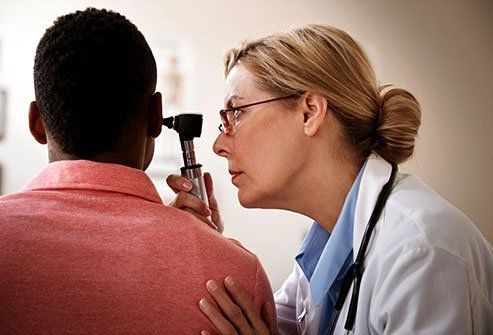
Polyps in the ears (also called otic or aural polyps) can come from many causes. They can develop from ear infections or tears, foreign objects in the ear, inflammation, tumors, and can even be present at birth. They can cause hearing loss, but the most common symptom of an aural polyp is bloody liquid draining from the affected ear.
How Are Aural Polyps Diagnosed and Treated?
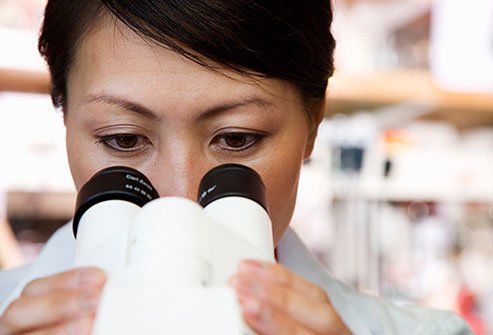
Doctors can look into your ear using an otoscope to see if you have one of these polyps. If it turns out you do, there are treatments available. You will be told to avoid getting your ears wet. You may also be prescribed medication, such as steroids or antibiotic ear drops. In some cases, removing them requires surgery.
What Is a Nasal Polyp?
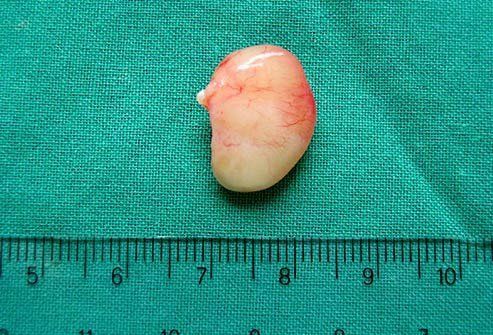
Polyps in the nose are called nasal polyps. They're very common. About 4% of us have them, and that may be a low estimate; cadaver studies put the number as high as 40%. Men are twice as likely to develop nasal polyps. They're also much more common in adults than children. What exactly causes them isn't known, but they're associated with a few risk factors. These include infection, chronic inflammation, allergies, cystic fibrosis, and aspirin sensitivity. One in three patients with nasal polyps also has asthma.
Nasal polyps usually grow in the shape of a teardrop. Most of them are noncancerous, and doctors can usually tell these apart from cancer, though more extensive testing may be necessary. If they're small, you don’t need to have nasal polyps treated. They may grow larger, however, and may need to be removed.
Nasal Polyp Diagnosis, Treatment, and Removal
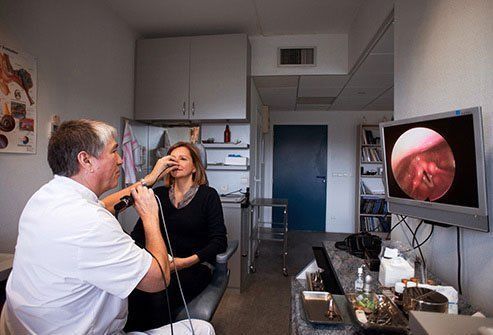
Most nasal polyps are small and cause little trouble. They can grow larger, however, and when they do it may be necessary for your doctor to remove them. Large polyps can cause obstruction, postnasal drip, loss of smell, facial pain, and fluid buildup in your nasal cavity. They can also sometimes be cancerous.
To determine whether your polyps need further treatment, your doctor will look into your nasal cavity using an otoscope. However, this may not be enough. One study showed that doctors missed the nasal polyps in more than half of their patients when using an otoscope alone. If you suspect nasal polyps, find a doctor who will use fiber optic rhinoscopy, a method considered the gold standard for diagnosing these cell clumps.
Treating Nasal Polyps
If your nasal polyps need to be treated, you may have options. Your doctor may recommend topical steroids, in which case both nose drops and sprays are available depending on the location of the polyps. If drops are administered, you may be asked to lie down first. Be sure to let your doctor know if you have diabetes, ulcers, or uncontrolled high blood pressure, all of which can cause problems with corticosteroids. For some, other steroids may be a better option.
If your polyps don't yield to steroids, you may be recommended for surgery. The most effective surgery seems to be endoscopic sinus surgery (ESS), though good results can be had with a traditional avulsion polypectomy. After surgery, you will need to use a nasal saline spray to keep the surgical area clean.
Uterine (Endometrial) Polyps
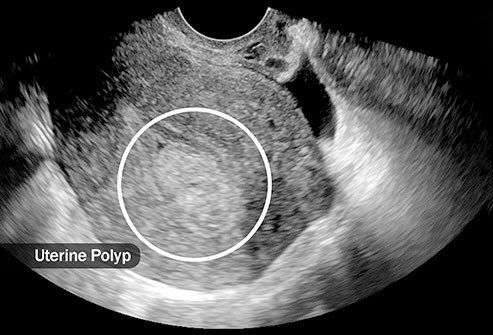
Polyps found in the uterus are sometimes called endometrial polyps. The endometrium is the lining of the uterus, which is where these growths occur. The growths may be round or oval, and they may be as tiny as a sesame seed or larger than a golf ball. Women in their 40s are most likely to develop these growths. They can sometimes form after menopause, but they are rare in women under 20. Certain factors put you at greater risk, including obesity, hypertension, and taking the breast cancer drug tamoxifen.
Uterine polyps are noncancerous (benign), but they can cause other problems. Women with uterine polyps may have difficulty conceiving. They may also experience heavier than normal bleeding during their periods or spotting between periods. Polyps can also make periods irregular.
How Are Uterine Polyps Diagnosed and Treated?

Your doctor will begin with a series of questions. Be sure to tell your doctor about any unusual characteristics of your periods, such as heavy bleeding or spotting. If you have taken notes when you experience these concerns, share them. These questions may be followed by a gynecological examination. Before the exam, ask your doctor to recommend any medications or antibiotics that should be taken first.
Several tests may be performed to confirm a diagnosis. These include transvaginal ultrasound, sometimes followed by sonohysterography, hysteroscopy and endometrial biopsy. Curettage is an operating procedure that can both diagnose and remove polyps.
Treating Endometrial Polyps
If you don't have any symptoms, you may not need to treat uterine polyps. Any that are found after menopause, that cause significant symptoms, or that stand in the way of pregnancy may need to be removed, though. Drugs can help temporarily relieve symptoms, but symptoms resume after these medications are stopped. Surgery is another option. Surgeries to remove these growths typically involve a hysteroscope and a curette.
Polyps in Your Vocal Cords?
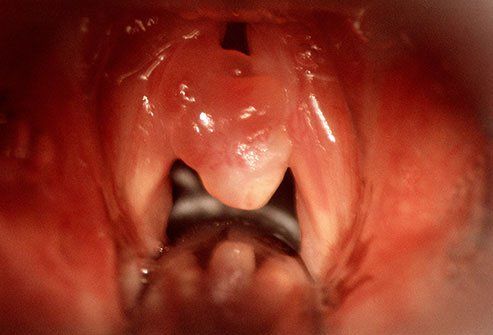
Polyps in the throat usually develop on only one half of your V-shaped vocal cords. Their shapes and sizes vary, and they interfere with the sound of your voice in many ways. Your voice may sound hoarse, scratchy, breathy, or rough. You may also experience pain shooting from ear to ear. Vocal polyps can cause fatigue, neck pain and a feeling that you have a lump in your throat. Vocal polyps are noncancerous.
What Causes Vocal Polyps?
When you have been shouting for a long time (think of a sporting event or a concert), you may injure your throat. That injury may result in producing a polyp. Other factors can contribute to these growths as well. Smoking and inhaling other irritants can cause them, and so can acid reflux. Polyps are a common health concern for adults.
Treating and Diagnosing Vocal Cord Polyps

To check for vocal polyps, a doctor will use either a mirror or a viewing tube called a laryngoscope. Sometimes a doctor will scrape your throat and send the results back for tests in a process known as biopsy.
Vocal polyps won't be cured without treatment, though the severity of their symptoms may vary from one day to the next. The simplest form of treatment is to simply let your voice rest. Your doctor may also recommend either voice or singing therapy. In this case a therapist will teach you how to use your voice in ways that causes less strain to your vocal cords. Depending on your needs, you may choose to undergo surgery.
One form of polyp removal surgery is called phonomicrosurgery. To perform this surgery, the surgeon uses a slender tube called an endoscope along with a microscope to remove the growth.
Are Stomach Polyps Cancerous?
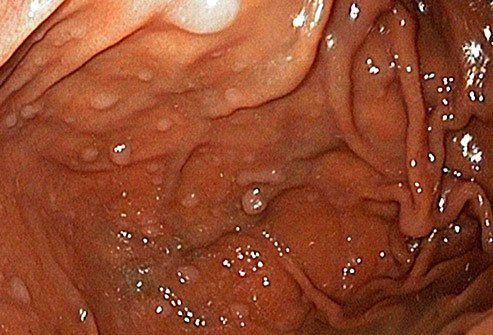
Stomach polyps, also known as gastric polyps, are not cancerous. Most of them don't increase your risk of developing stomach cancer either. However, one type of stomach polyp, adenomatous polyps (adenomas) sometimes do develop into cancer. Adenomas make up about 6% to 10% of all polyps found in Western countries like the United States.
Usually stomach polyps don't show any symptoms. Sometimes they grow large, though, and when they do they can develop ulcers. While usually without symptom, some symptoms can arise, including abdominal pain, anemia, bloody stool, and nausea. On rare occasions, these growths can become so large that they block the entrance to the small intestine.
Diagnosing and Treating Stomach Polyps

If you have gastric polyps, it's important that they are discovered, and discovered early. That's because these growths can sometimes develop into cancer. Because they usually show no symptoms though, stomach polyps are often found by accident when a doctor examines the stomach using an endoscope. When endoscopies are performed, about 6% of patients have polyps.
Not all polyps need to be removed. Depending on their type and size, your doctor may recommend leaving them alone. But polyps that are more likely to develop into cancer, and polyps that are causing or likely to cause other symptoms, may need to be removed. This is called polypectomy, and is typically performed using an endoscope.











